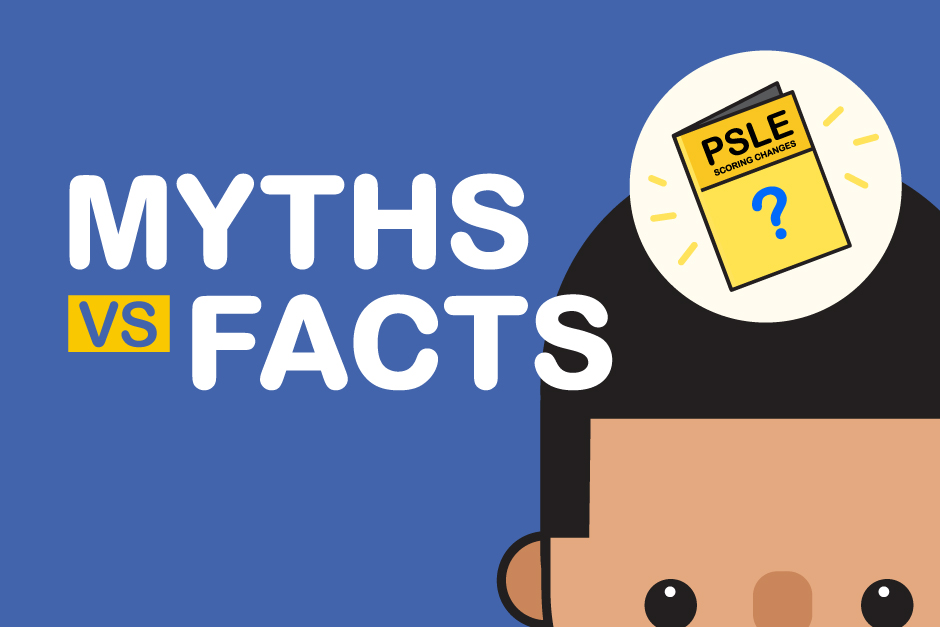| Myth 1: The changes to the PSLE scoring system will make the PSLE more difficult. | Fact: The new PSLE scoring system will not affect the curriculum and assessment standards of the PSLE.
MOE reviews the curriculum regularly to ensure that it is relevant and up-to-date. This will continue as per current practice and is independent of the changes to the PSLE scoring and S1 posting. |
| Myth 2: The new passing mark for PSLE subjects is 65 based on the new AL6 band. | Fact: There is no passing or failing mark for each PSLE subject, or the PSLE as a whole.
The PSLE is a placement exam to guide students to take subjects in secondary school at levels that best suit their educational needs at the point of entry to secondary school. This will allow them to learn and progress at a comfortable A student who obtains a PSLE Score of 26 to 30, and scores an AL 7 or better in both English Language and Mathematics – or AL B or better at Foundation level for these subjects – can progress to the Normal (Technical) course |
| Myth 3: The scoring bands under the new system are uneven and wider at the middle and lower ranges, thus disadvantaging the “average” student. | Fact: The AL bands are designed to reflect students’ stages of understanding and mastery of the particular subject, while ensuring meaningful S1 Posting outcomes.
The upper AL bands have a narrower raw mark range as around half of the students taking standard subjects today score above 75. These narrower mark ranges are needed to avoid having too many students achieving the same PSLE Score, which For the middle to lower AL bands, students’ scores are expected to be more widely distributed, and the wider raw mark ranges are sufficient to give a good indication of a student’s understanding and readiness for the next course The approach taken provides a balance between reducing undue differentiation between students’ exam results and ensuring meaningful posting outcomes. |
| Myth 4: Fewer students will be eligible for the Express course with the changes in the new PSLE scoring system. | Fact: The proportion of students qualifying for different courses under the new scoring system will remain largely similar to the T-score system.
Students will qualify for the respective courses as long as their PSLE Scores meet the placement criteria. Under the new standards-referenced scoring system, if more students demonstrate the requisite level of achievement to cope with and benefit from a more demanding course, they will be eligible for that course. |
| Myth 5: My child will need to take a subject at the N(A) level as long as he/she gets AL 6 to AL 8 for that subject. | Fact: Your child will take all subjects at the Express level if he/she is placed in the Express course.
Students whose PSLE Scores qualify them for the Express course will have demonstrated that they possess the overall ability to cope with the demands of the course. Hence, they may take all subjects at the Express level, even if they scored Students whose PSLE Scores qualify them for the N(A) or N(T) courses may offer certain subjects at N(A) or Express level if they score AL 5 or better in a Standard level subject at the PSLE. They will be eligible to take the subject at |
| Myth 6: Because of the scoring bands under the new PSLE scoring system, more students will have to undergo balloting. | Fact: Based on MOE’s simulations, about 9 in 10 students will not need to undergo balloting.
Posting to secondary school will still be based on academic merit. Tie-breakers will only be used if there is more than one student with the same PSLE Score vying for the last available place in a school: Order of tie-breakers:
Students will only be balloted when those vying for the last place in the same school have the same PSLE Score, citizenship and choice order of schools. |
| Concluding section | For more information on the changes to the PSLE scoring and Secondary One (S1) posting systems, visit the PSLE-FSBB microsite. |




.jpg)

